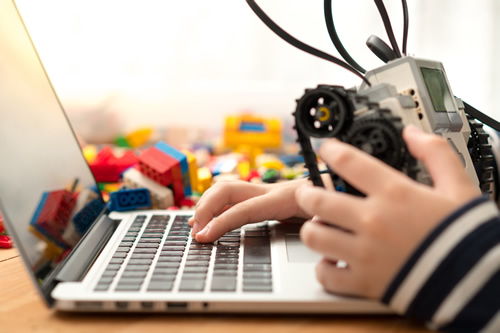On a visit to a class in Sitka, Alaska, we watched second grade students gain incredible experiences in computer science skills. The teacher, Cindy Duncan, believes in teaching young children to code, so she begins the year by introducing students to Ozobots through stories.
She used “The Gingerbread Man” and taught dyads of children to develop story characters. “I teach coding and robotics because as an educator it is my job to recognize that my students are global innovators, thinkers and problem solvers,” she explained.
Related content: 6 reasons to support K-5 coding
Everywhere you turn, teachers, parents and others are talking about coding and robotics for learners of all ages. Based deeply on the ideas of Seymour Papert, robotics and coding provide hands-on and creative opportunities for learners to invent, solve problems and create – perhaps the most appropriate implementation of STEM. These experiences provide the opportunity to teach STEM in a multidisciplinary way, with a hands-on approach, which also happens to be engaging and fun.
What once was offered only to high school students is now available in preschools, elementary classes, after-school sessions and summer camps.
The number of resources for teaching computer science in these various environments is also growing. Here are a few:
- Sesame Workshop has developed a course for educators called “Make Believe with Math.”
- The Grable Foundation will invest $1 million to encourage early STEM learning through the development of robust hands-on activities for young children.
- The National Science Teachers Association (NSTA) is creating the NSTA Initiative for Learners 0-5, a streamlined array of NSTA resources – many of them at no cost – to preschool and elementary school educators, parents and child care providers who will engage our youngest learners in STEM.
Many organizations and schools are taking up the challenge and embedding coding and robotics into their programs. Code.org is dedicated to expanding access to computer science and increasing the participation of women and underrepresented minorities. Code.org organizes the annual Hour of Code campaign that has engaged 10 percent of all students in the world and provides the leading curriculum for K-12 computer science in the largest school districts in the United States.
Schools everywhere are offering a variety of programs to support the development of coding and robotics skills in all their students. The McLean School in Potomac, Maryland, is proud of its robotics curriculum that promotes digital age skills in technology, teamwork and creativity. Students use Lego WeDo, Lego Mindstorms EV3 robots and free-form robotics to learn and also to participate in national competitions.
The South Fayette School District in McDonald, Pennsylvania, approached the inclusion of STEM, coding and robotics by restructuring its curriculum. By involving all stakeholders and focusing on teaching computational thinking, the district created a dramatically changed program that’s earning recognition. This transformation didn’t happen overnight; it was a planned, iterative process.
Robotics and coding within STEM and STEAM initiatives have become universal throughout educational entities around the globe. For example, 10 and 11-year-old students in Dubai invented a robot that tracks the sun’s movement and adjusts solar panels throughout the day, allowing the panels to capture the maximum amount of energy from the sun.
Student teams participating in the 2017 FIRST Global Robotics Games are addressing the water crisis by developing solutions to store drinkable water, filter contaminated water and find new sources of clean water.
The San Juan School District in San Juan Island, Washington, committed to STEM education through its STEM center, with a goal that every learner have the opportunity to experience its rich and diverse curriculum.
While many educators never learned to code, resources abound to help us all get started. These new tools that are readily accessible and often free, make coding and creating robots an enjoyable experience that can easily be integrated into any content area.
Here are few ways to join the excitement:
- Download a free handbook that describes how Remake Learning created a special collaborative educational network focused on igniting “engaging, relevant, and equitable learning practices to support young people navigating rapid social and technological change.”
- Look for free tutorials and courses that help educators get started with coding and robotics.
- Try the Massachusetts Institute of Technology’s free simple coding tools, Scratch and Scratch Jr.
- Teach students to build small robots and droids with littleBits.
- Guide students in creating their own computer games with Python.
[Editor’s note: This post originally appeared on the ISTE Blog and is reposted here with permission.]
- High school students say AI will change the workforce - April 18, 2024
- Motivating students using the Self-Determination Theory - April 17, 2024
- Michigan Virtual’s statewide workgroup releasing AI guidance for K-12 educators - April 17, 2024

